Last Updated on February 18, 2025 by Owen McGab Enaohwo
![Digital Transformation? [What It Entails + Real-Life Examples]](https://www.sweetprocess.com/wp-content/uploads/2025/02/digital-transformation.png)
You know your current systems are holding you back.
Maybe your team is drowning in manual processes, or your competitors are gaining an advantage with sleek, tech-driven solutions. Perhaps you’re struggling to meet customer expectations in an era where convenience and speed are non-negotiable.
Whatever the case, the writing is on the wall—sticking to the old ways is putting your business at risk.
The answer is to integrate technology not as a quick fix but as a core part of your growth strategy.
But shifting in this direction can feel overwhelming. What does digital transformation actually involve? Where should you start? And how can you learn from companies that have successfully navigated this shift?
In this guide, we’ll explain digital transformation, its components, its impact, and how businesses of all sizes can embrace it.
Taking that first step doesn’t have to be complicated. You don’t need to figure it all out at once. The key is starting with a system that helps you map out what needs to change. And SweetProcess can help. It’s a tool designed to simplify documenting and managing your workflows so your team has clear processes to follow. Get started with a free trial of SweetProcess — no credit card required.
What You’ll Learn In This Guide:
What Is Digital Transformation?
3 Foundational Elements of Digital Transformation
11 Benefits of Digital Transformation
How to Streamline Your Company’s Digital Transformation With SweetProcess
How to Accelerate Digital Transformation (in 9 Steps)
5 Real-Life Examples of Digital Transformation to Learn From
6 Digital Transformation Strategies and Roadmaps
Challenges of Digital Transformation and How to Overcome Them
The Role of AI in Digital Transformation
Enhance Your Company’s Digital Transformation Process Using SweetProcess
What Is Digital Transformation?

Digital transformation is the process of integrating digital technologies into every aspect of a business to change how it operates and delivers value to customers.
It involves leveraging technologies like cloud computing, artificial intelligence, data analytics, and automation to streamline operations.
For you, this could mean automating repetitive tasks to free up time for more strategic work, adopting cloud-based systems to improve flexibility, or using data analytics to gain deeper insights into customer behavior.
The effects of digital transformation on a company can be profound. You can expect streamlined workflows, faster decision-making, and improved customer experiences. For example:
- Automating manual processes can reduce errors and save time.
- Cloud-based tools make collaboration easier for remote teams.
- Advanced analytics can help you anticipate market trends and make smarter, data-driven decisions.
3 Foundational Elements of Digital Transformation
To transform, businesses must focus on three foundational elements: physical, cognitive, and cultural. These elements work together to create a holistic framework for digital transformation.
1. Physical
The physical element refers to the tools, systems, and infrastructure that enable change. This includes hardware like servers, IoT devices, or upgraded computers, as well as software such as cloud platforms, CRM systems, and workflow automation tools.
This might mean transitioning from outdated, manual systems to scalable, cloud-based solutions for your business. Physical upgrades provide the foundation for smoother operations, better data management, and enhanced team collaboration.
2. Cognitive
The cognitive element focuses on data, analytics, and decision-making. In the digital age, businesses have access to vast amounts of data, but the real value lies in how you use it. Cognitive transformation involves leveraging artificial intelligence (AI) and machine learning to analyze data, uncover insights, and make smarter, data-driven decisions.
3. Cultural
The cultural element often determines whether a digital transformation strategy succeeds or stalls. It’s about shifting your organization’s mindset to embrace change, foster collaboration, and prioritize innovation. This includes training your team to adopt new technologies and encouraging a culture of adaptability.
Understanding these foundational elements is just the beginning. The real challenge lies in aligning them to create a seamless transformation process. With SweetProcess, you can easily streamline your processes, track progress, and ensure your team is aligned at every step.
11 Benefits of Digital Transformation
From streamlining operations to boosting customer satisfaction, here are 11 key benefits of embracing digital transformation.
1. Closing the Global Digital Divide
Gone are the days when only big corporations could compete globally. Digital transformation initiative levels the playing field, allowing even small businesses to reach international markets and connect with customers worldwide.
By leveraging tools like cloud computing, e-commerce platforms, and digital marketing, businesses can gain access to international audiences, suppliers, and talent.
2. Developing Secure and Reliable Digital Systems
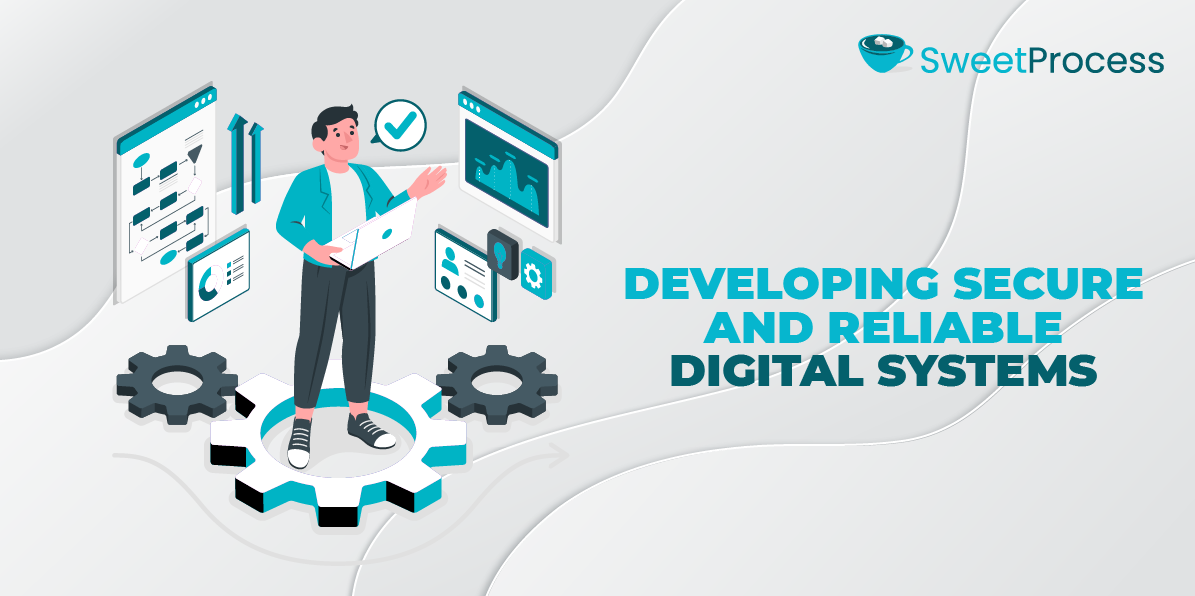
Cyber threats are everywhere. In the second quarter of 2024, organizations worldwide faced an average of 1,636 cyber attacks per week, marking a 30% year-over-year increase.
Digital transformation helps you create systems that are efficient and secure so that you can protect your business and your customers’ trust.
3. Data-Driven Decision-Making
Data is a powerful resource for making informed business decisions. Digital transformation enables you to collect, analyze, and interpret vast amounts of data in real time.
4. Innovation Opportunities
When you integrate cutting-edge technologies, you unlock the potential to innovate in ways that weren’t possible before. This could mean developing new products, creating personalized customer experiences, or exploring entirely new business models.
5. Improved Customer Experience
Customers today expect seamless, personalized, and efficient interactions—and digital transformation delivers. Tools like chatbots, CRM systems, and personalized marketing campaigns help businesses anticipate and meet customer needs, building loyalty and satisfaction.
6. Enhanced Efficiency
Automation and streamlined workflows are hallmarks of digital transformation. Automating repetitive tasks and optimizing operations can reduce errors, save time, and increase productivity. For instance, automating supply chain processes ensures timely deliveries and reduces manual intervention, leading to cost savings and improved performance.
7. Scalability and Growth

Growing your business shouldn’t mean drowning in complexity. Digital transformation gives you the flexibility to scale without breaking a sweat, whether you’re expanding your team or entering new markets.
8. Increased Agility
The ability to pivot quickly in response to market changes is critical for long-term success. Digital transformation equips you with the tools and processes to adapt rapidly. For example, access to real-time data allows organizations to adjust strategies instantly, while cloud-based platforms enable remote work and decentralized decision-making.
9. Enhanced Collaboration
Digital tools like project management software, real-time communication platforms, and shared cloud environments foster better team collaboration. Employees can work together seamlessly, regardless of location, leading to faster decision-making, improved problem-solving, and greater innovation.
10. Improved Security Measures
As cyber threats become more sophisticated, digital transformations ensure businesses stay ahead with robust security protocols. Advanced threat detection, automated system updates, and comprehensive compliance measures reduce vulnerabilities and protect critical assets. Improved security also minimizes downtime and the financial risks associated with data breaches.
11. Driving Long-Term Sustainability
Businesses can reduce paper usage, optimize energy consumption, and create efficient workflows by digitizing operations. These sustainability initiatives align with environmental goals and resonate with eco-conscious consumers, enhancing brand reputation.
Unlocking these benefits requires the right tools to streamline and document your processes effectively. SweetProcess offers an intuitive platform to help you manage workflows, improve collaboration, and easily scale your business.
How to Streamline Your Company’s Digital Transformation With SweetProcess
Digital transformation completely shifts how your business operates. It touches every part of your organization, from automating workflows to empowering teams.
But transformation at this scale comes with its challenges:
- How do you ensure processes stay consistent as you adopt new tools?
- How do you get everyone on the same page during such a fundamental change?
This is where structure becomes essential, and SweetProcess offers just that. With SweetProcess, you can document your workflows, manage processes step by step, and ensure every team member knows exactly what to do and when.
In the next sections, we’ll show you how to use SweetProcess to simplify and streamline your digital transformation.
Creating a Business Process
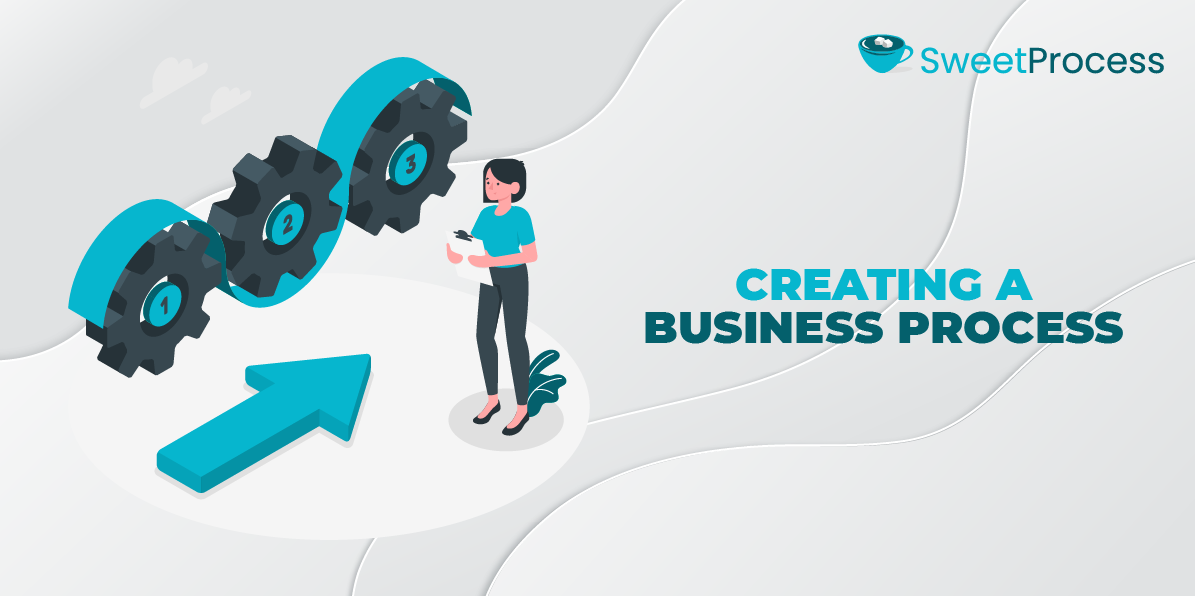
The first step in using SweetProcess to drive your digital transformation is creating a well-defined business process. This ensures your team has a clear roadmap, reduces misunderstandings, and enhances consistency.
Here’s how to create a business process in SweetProcess step by step:
1. Navigate to the Processes Tab
Start by logging in to your SweetProcess account and clicking on the “Processes” tab. This is your central hub for creating and managing all workflows. Think of it as the command center where every process is documented and accessible.

2. Click “Create Process”
In the top-right corner, select the “Create Process” button. This opens a blank template where you can outline the steps and structure of your workflow. The simplicity of this interface ensures you can start building processes without needing any technical expertise.

3. Add a Descriptive Title
Enter a clear and specific title for the process. For instance:
- Streamlining Employee Onboarding Workflow
- Optimizing Customer Feedback Collection
A descriptive title helps team members immediately understand the purpose and context of the process.

4. Assign the Process to Relevant Teams
Assign the process to the departments or teams responsible for executing it. SweetProcess allows you to categorize processes, ensuring the right people have access and know their roles. Then click “Continue.”
5. Add a Description
On the next page, provide a short description to explain the purpose of the process. Just below the title, you’ll see “Click to add tags or description.” For example, This process outlines the steps for collecting and analyzing customer feedback to improve product offerings. Descriptions add context and clarity, especially for teams new to the process. Then click “Finished Editing” to save the description. You can also add a tag at this step.
Tags make it easier to locate and group related workflows, improving navigation and efficiency in managing information.
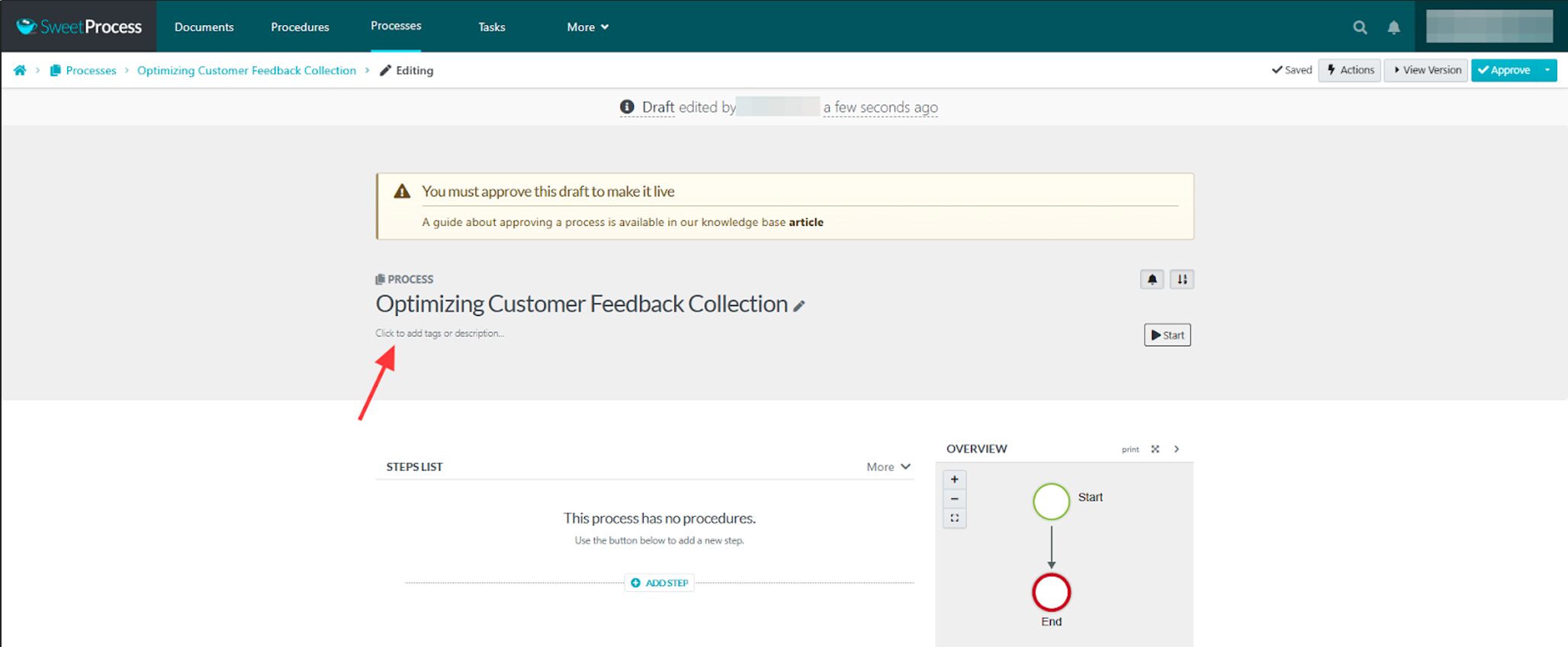
6. Build the Process Step by Step
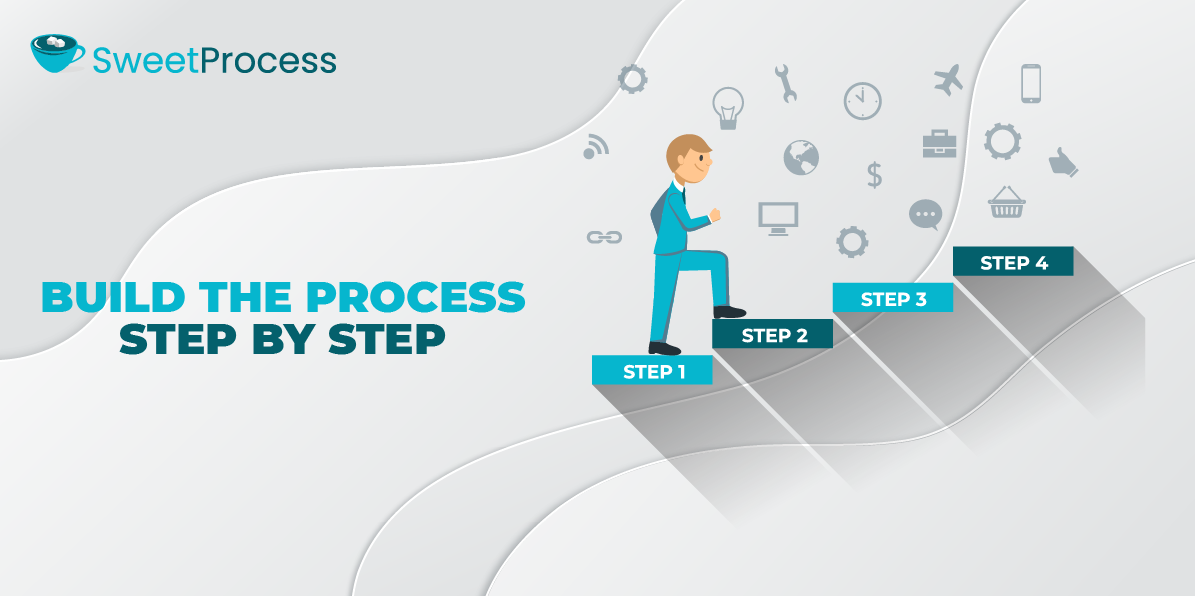
Now, add steps to your process. Click the “Add Step” button. SweetProcess provides three options to structure workflows:
- Procedure: For detailed, step-by-step instructions
- Decision: For points where the workflow branches based on specific criteria
- End Step: To mark the conclusion of the workflow
Example: Prepare for Digital Transformation
- Step Title: Prepare for Digital Transformation
- Actions:
- Review current workflows and identify inefficiencies
- Engage key team members to gather feedback on areas of improvement
- Define measurable goals for the transformation project
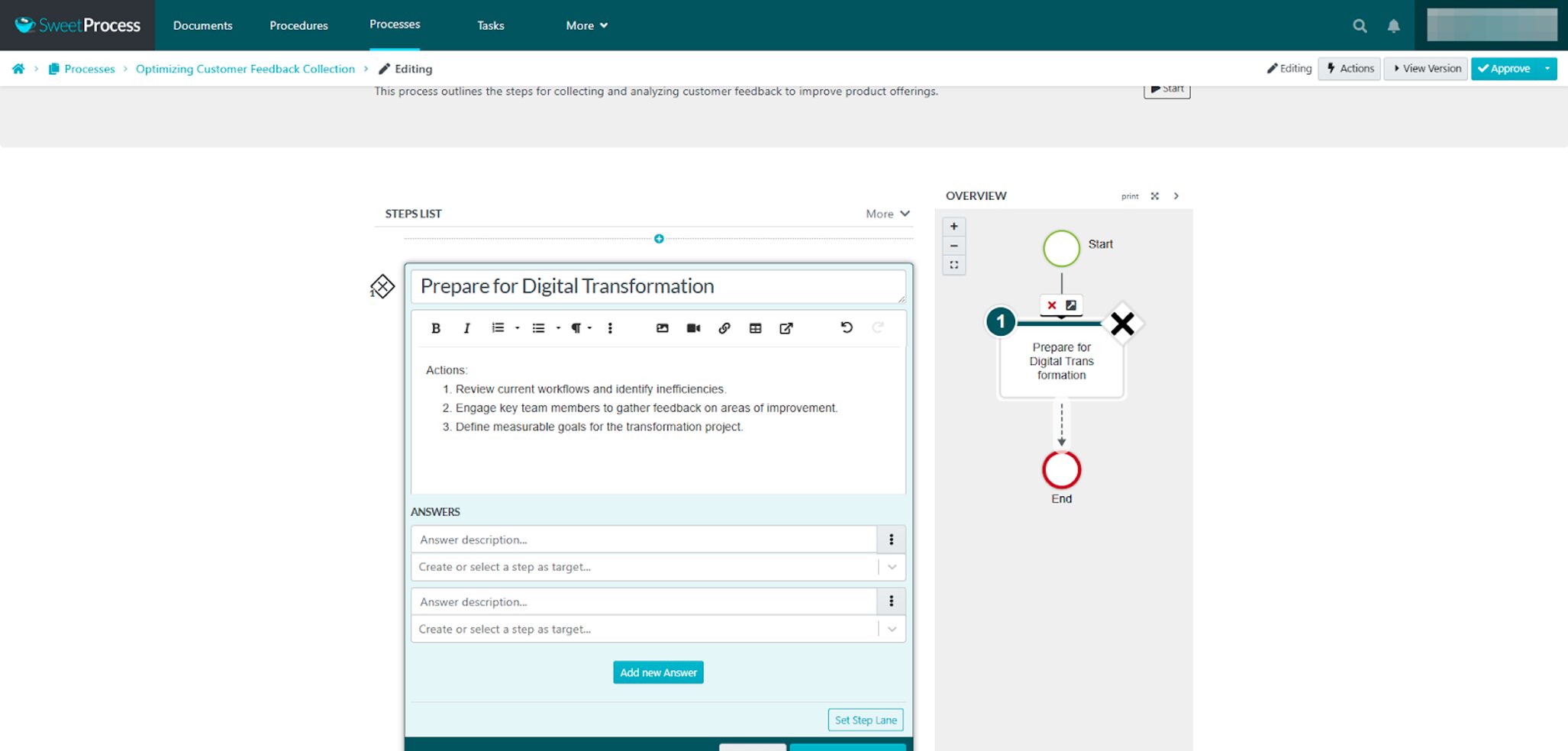
Repeat this for additional steps, such as Implement New Tools or Train Employees on New Processes. Ensure the final step is marked as an “End Step” to signify process completion.
Once you have added and reviewed all steps:
- Click the “Approve” button in the top-right corner of the screen.
- SweetProcess will lock the workflow as a finalized version, ensuring consistency across teams.
Document Your Company’s Procedure

After defining your business processes, the next step in managing your digital transformation is documenting the procedures that make up those processes.
Procedures break down the tasks within a process into clear, actionable steps, ensuring consistency and accuracy across your team. SweetProcess simplifies the documentation process, making it easy to create, edit, and manage procedures that align with your transformation goals.
Here’s how to document a procedure in SweetProcess:
1. Navigate to the “Procedures” Tab
Click on the “Procedures” tab in your SweetProcess dashboard. This is where all procedures are created and managed. Think of it as your library of operational knowledge—every task your team needs to perform, stored in one organized place.
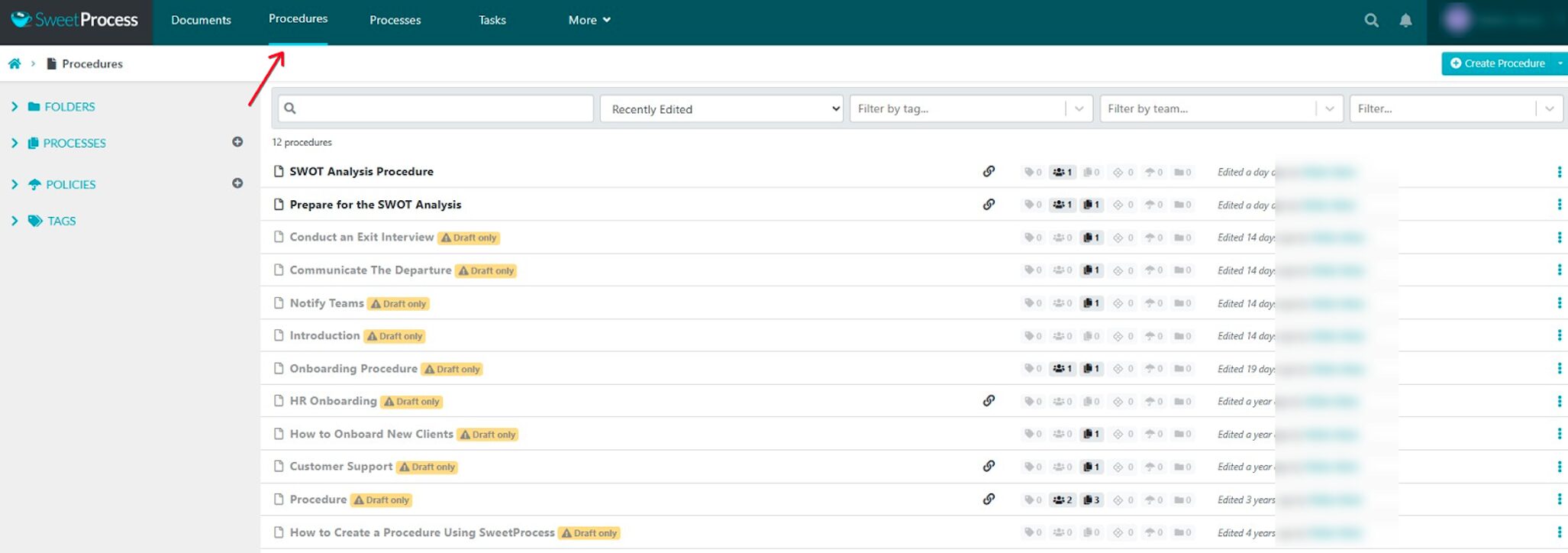
2. Click “Create Procedure”
In the top-right corner, select the “Create Procedure” button. This opens a blank template, allowing you to define every aspect of your procedure.
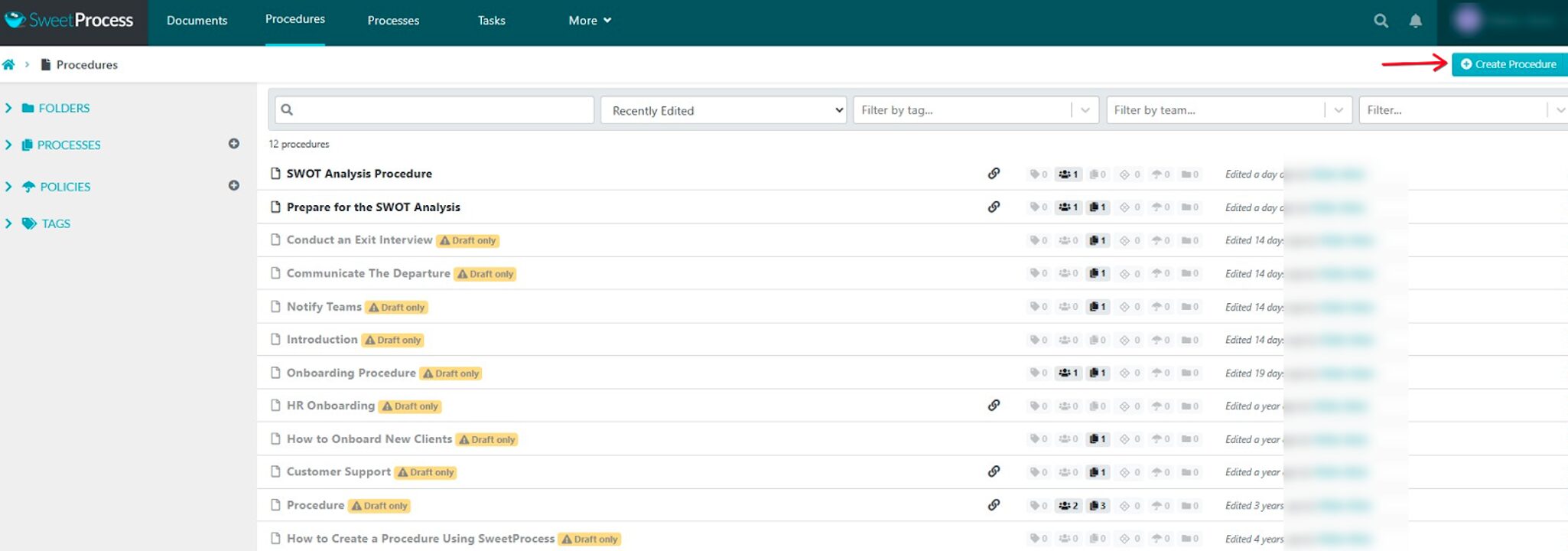
3. Enter the Procedure Title
Choose a clear, specific title that describes the task. For example:
- Implementing a New CRM System
- Conducting a Team Training Session on Cloud Tools
A well-defined title ensures your team immediately understands the purpose of the procedure.
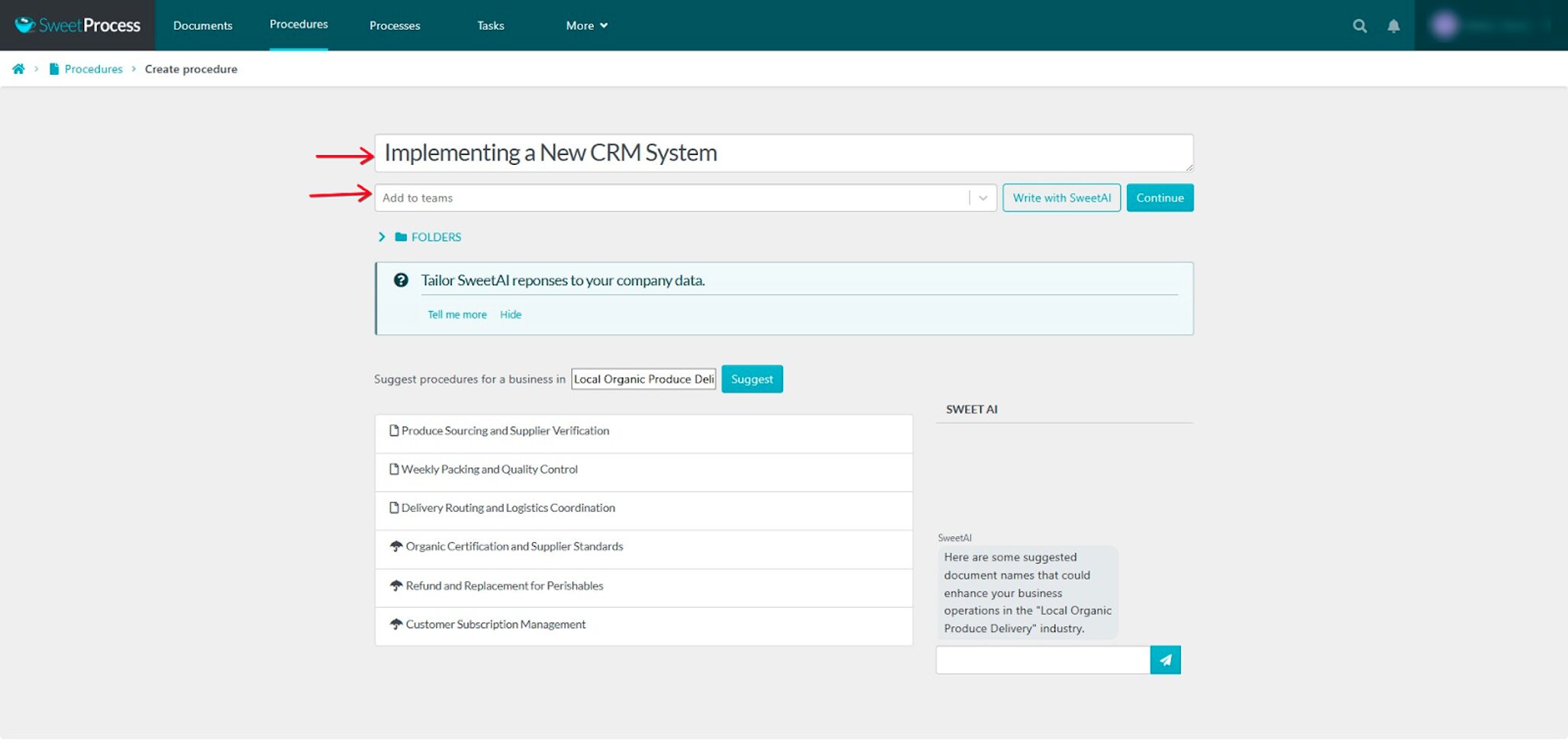
4. Assign the Procedure to Teams
Designate the teams responsible for carrying out this procedure. For instance, if the procedure involves implementing a new CRM system, it might involve both the IT and sales teams. Assigning teams ensures accountability and accessibility. Then click “Continue.”
5. Add a Description

To add a description, click on the pencil icon next to your procedure title and add a detailed description. For example:
“This procedure outlines the steps for implementing a new CRM system, including setup, data migration, and team onboarding. It ensures a smooth transition with minimal disruptions to daily operations.”
Descriptions provide context and clarify the scope of the procedure, making it easier for team members to understand its importance. You can also add tags.
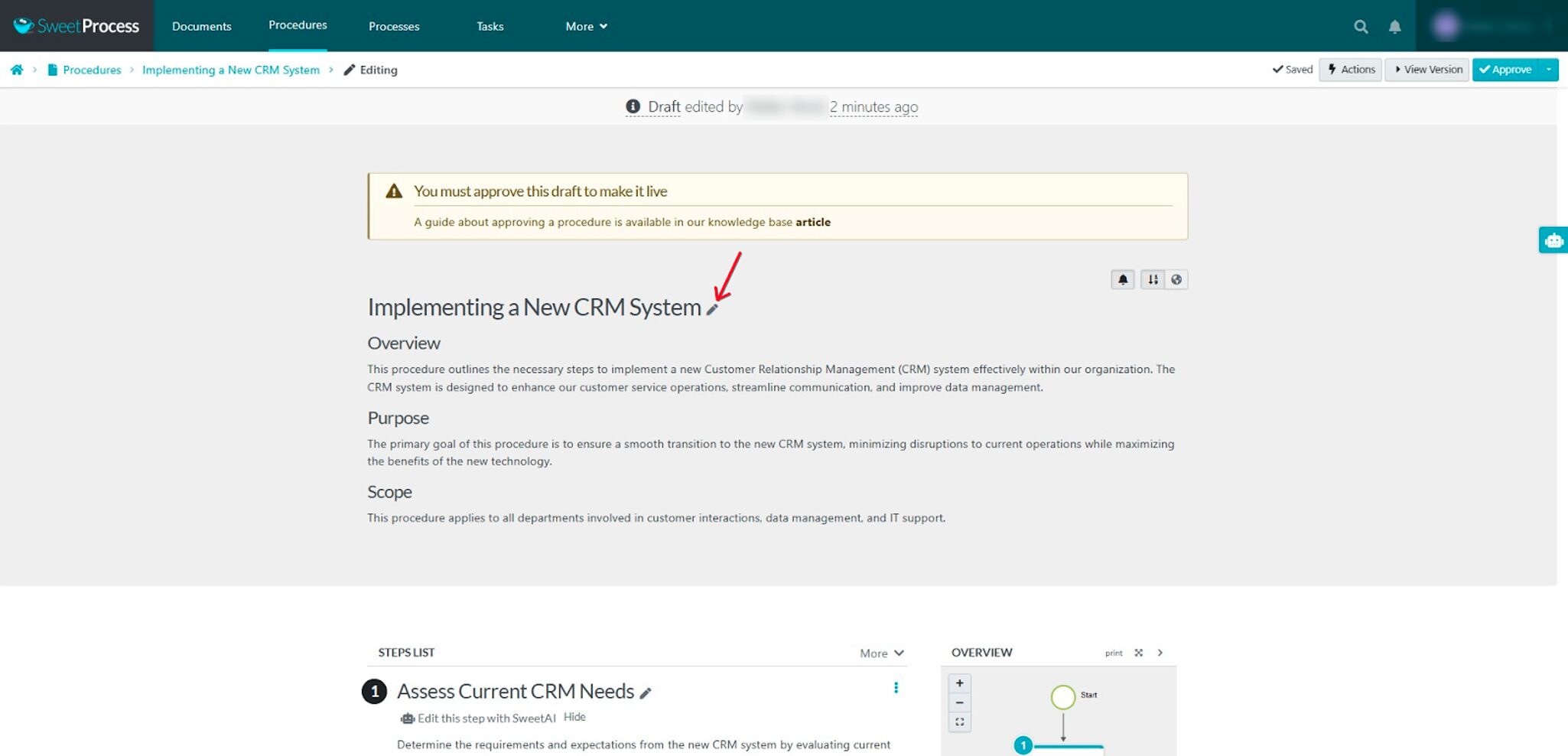
6. Add Steps to the Procedure
Break down the procedure into manageable steps, ensuring each step is clear, concise, and actionable. Here’s how to add steps in SweetProcess:
- Click “Add Step” and provide detailed instructions, examples, or visuals.
For example, for the procedure Implementing a New CRM System, the steps might include:- Assess existing customer data and identify migration needs
- Configure the CRM platform according to business requirements
- Train team members on using key CRM features
- Monitor usage and address any technical issues
Note: Use SweetAI for Faster Documentation
SweetProcess offers the SweetAI feature to automatically generate the procedures. Simply enter the procedure title as a prompt, click “Write with SweetAI,” and the AI automatically generates detailed steps, a flowchart, and descriptions. Review the content, make adjustments if needed, and save time on manual documentation.
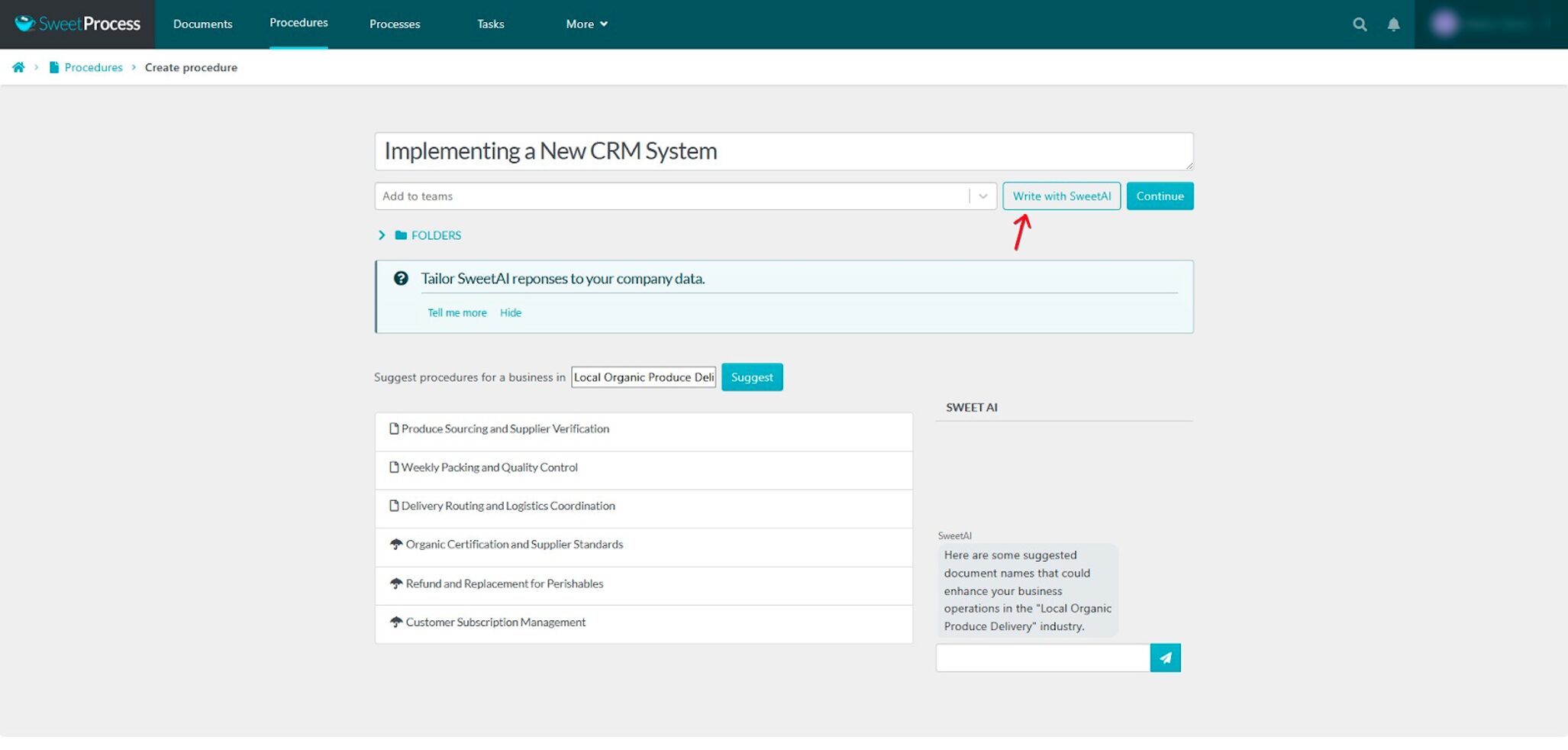
7. Approve and Save the Procedure
Once your procedure is complete, click “Approve” in the top-right corner to finalize it. This ensures the procedure is saved, accessible to your team, and ready for use.
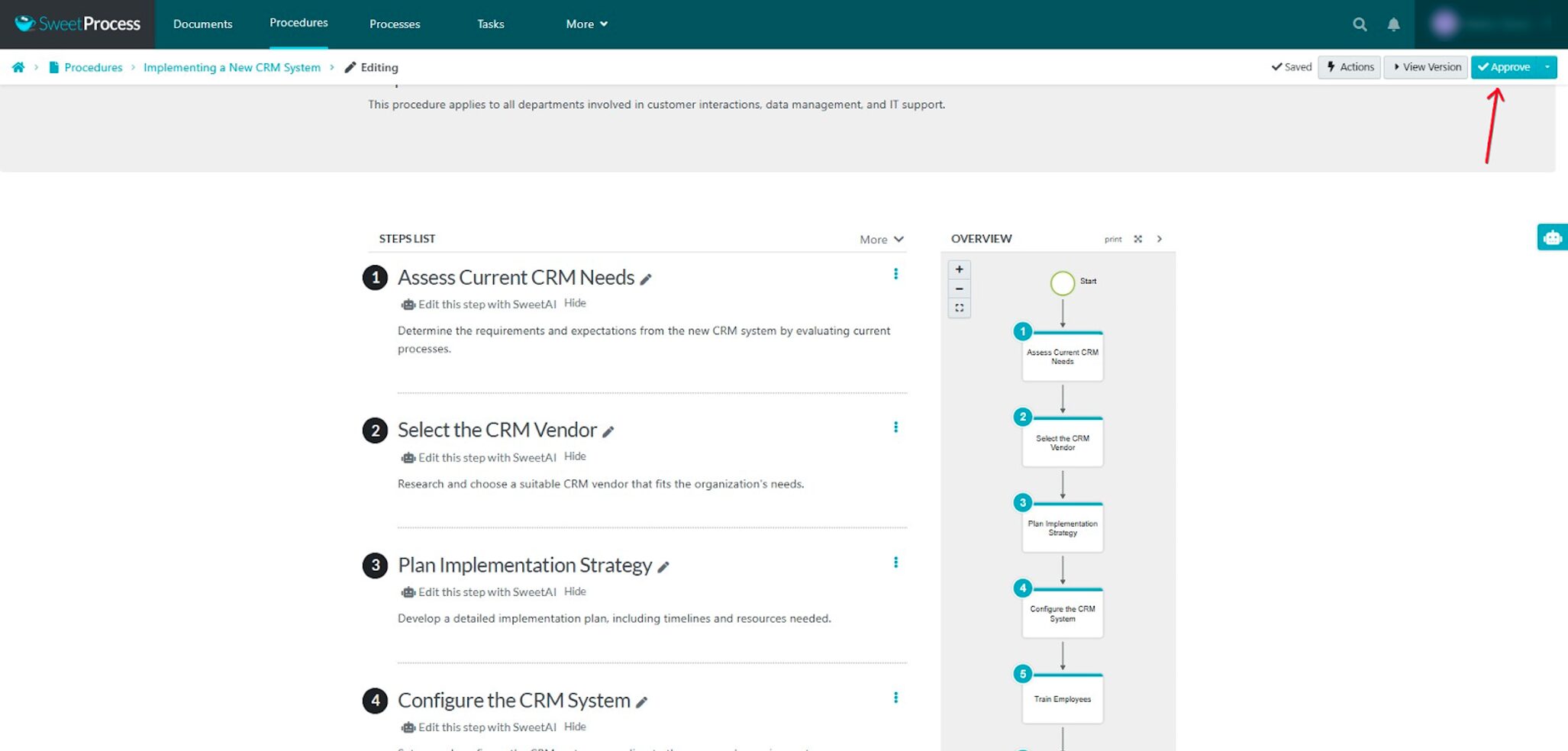
By documenting procedures with SweetProcess, you establish a reliable foundation for digital transformation.
Add a Procedure to a Business Process
After documenting your procedures in SweetProcess, the next step is integrating them into your business processes. This ensures your workflows are cohesive, streamlined, and accessible to your team.
Adding procedures to a process in SweetProcess is straightforward and allows you to build a comprehensive, step-by-step roadmap for your digital transformation.
Here’s how to add a procedure to a business process:
1. Navigate to the “Processes” Tab
Start by clicking the “Processes” tab in the top menu. This is your central location for managing and editing all business processes.
2. Select the Process
Click on the process you want to update. For instance, if you’re building a workflow for Migrating to Cloud-Based Collaboration Tools, select that specific process to open it.

3. Edit the Process
In the top-right corner, click the “Edit” button to begin making changes to the process. This allows you to add, modify, or rearrange steps as needed.
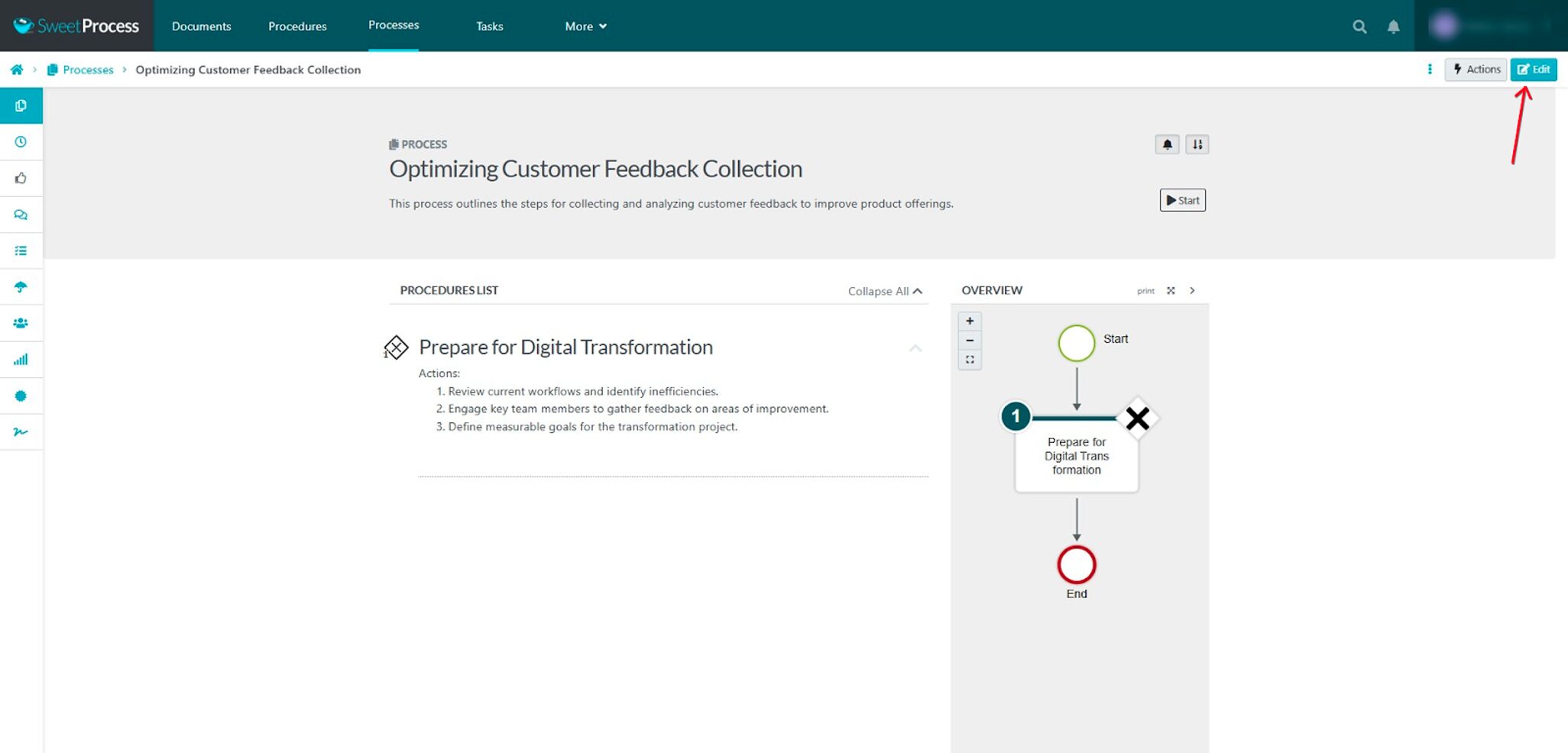
4. Add a Procedure as a Step
On the steps list, click the “+” sign to add a new step. A pop-up menu will appear, offering you options for the type of step to add. Select “Procedure.”
This will open a list of all the procedures you’ve documented in SweetProcess. Scroll through the list to find the relevant procedure and click on it to add it to the process.
For example, if your process is titled Migrating to Cloud-Based Collaboration Tools, you might add the procedure Configuring Team Communication Platforms as a step.
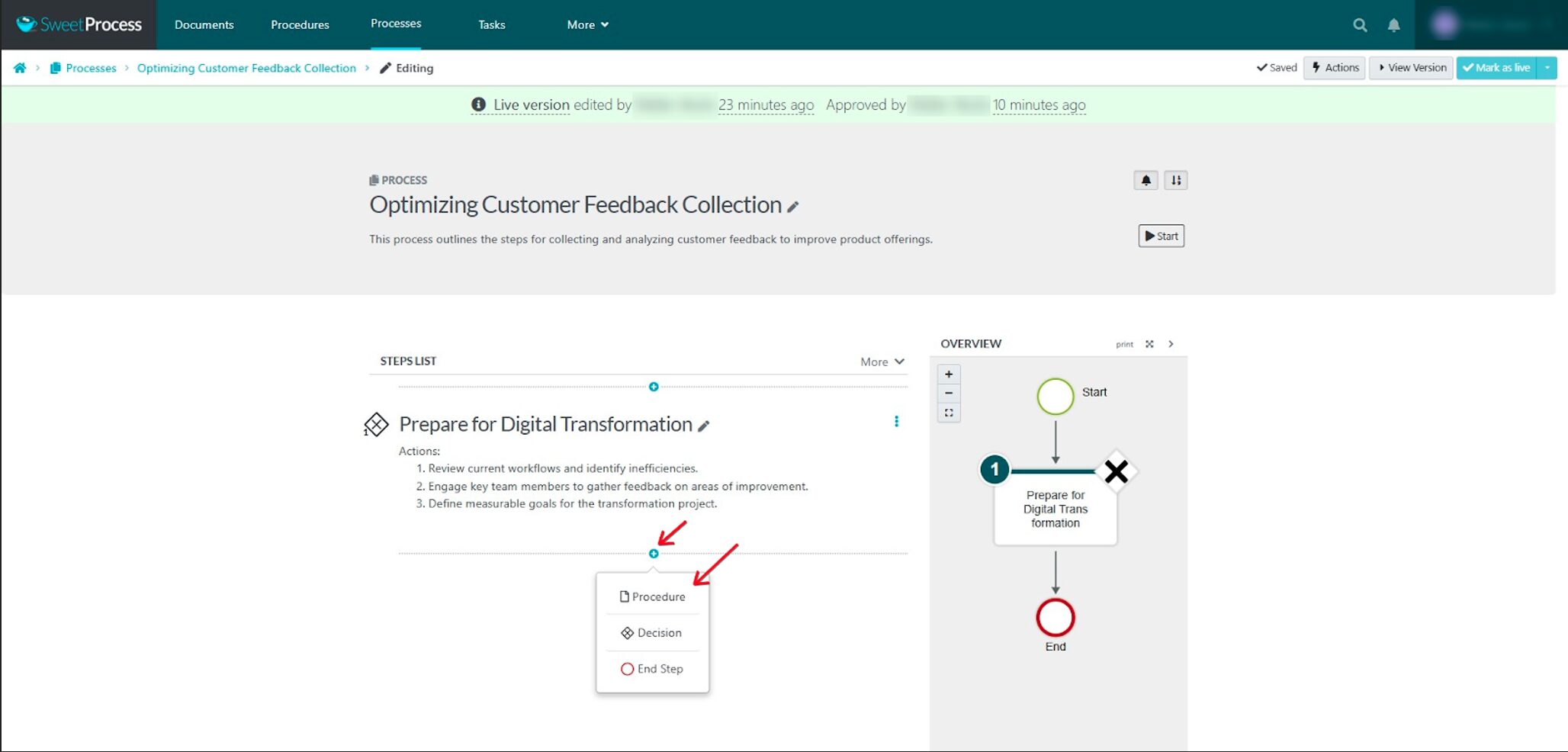
5. Repeat to Add More Procedures
Repeat the above steps to include additional procedures in the process. This ensures that every part of your workflow is covered, from planning to execution.
6. Save the Process

Once you’ve added all necessary procedures, click “Mark as Live” in the top-right corner to save your changes. This finalizes the process and makes it accessible to your team.
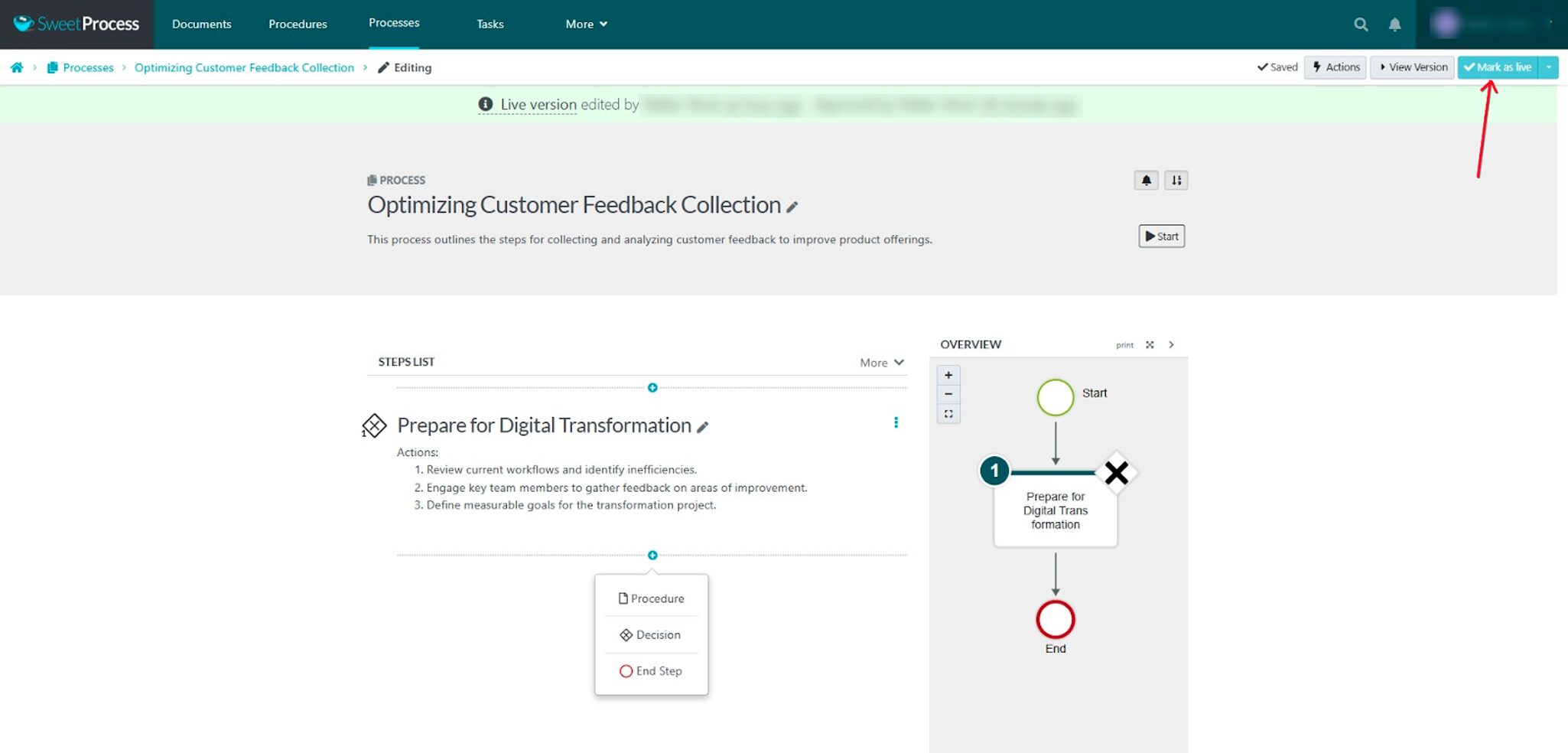
Integrating procedures into business processes creates a unified workflow that simplifies complex operations. For example, a company implementing a Digital Marketing Automation Process can link procedures like Setting Up Email Campaigns and Analyzing Campaign Performance, ensuring every team member knows their role and responsibilities.
Manage Your Company’s Procedures and Processes
Effective management of procedures and processes is essential for maintaining consistency and ensuring that your workflows remain efficient and up-to-date.
SweetProcess offers robust tools to help you organize, update, and track changes in your workflows. Here’s how you can manage your procedures and processes effectively.
1. Organizing Procedures and Processes
Use Tags and Categories
SweetProcess makes it easy to organize your procedures and processes by adding tags. Tags act as keywords, allowing you to categorize and quickly locate workflows.
For example, if you’re managing multiple digital transformation projects, you can tag procedures with labels like “Onboarding,” “Automation,” or “Training.”
Here’s how to add a tag:
- While editing a procedure’s description or title, locate the “Add a Tag” input box.
- Enter the desired tag (e.g., Digital Tools) and press Enter on your keyboard.
- The tag will be saved and indexed, making filtering or searching for related procedures easier.
How This Helps
Tags provide an intuitive way to navigate large libraries of workflows, saving time and reducing confusion for teams. For instance, during a system-wide review, you can quickly pull up all procedures tagged “System Updates” for a focused audit.
Create Teams and Assign Relevant Procedures
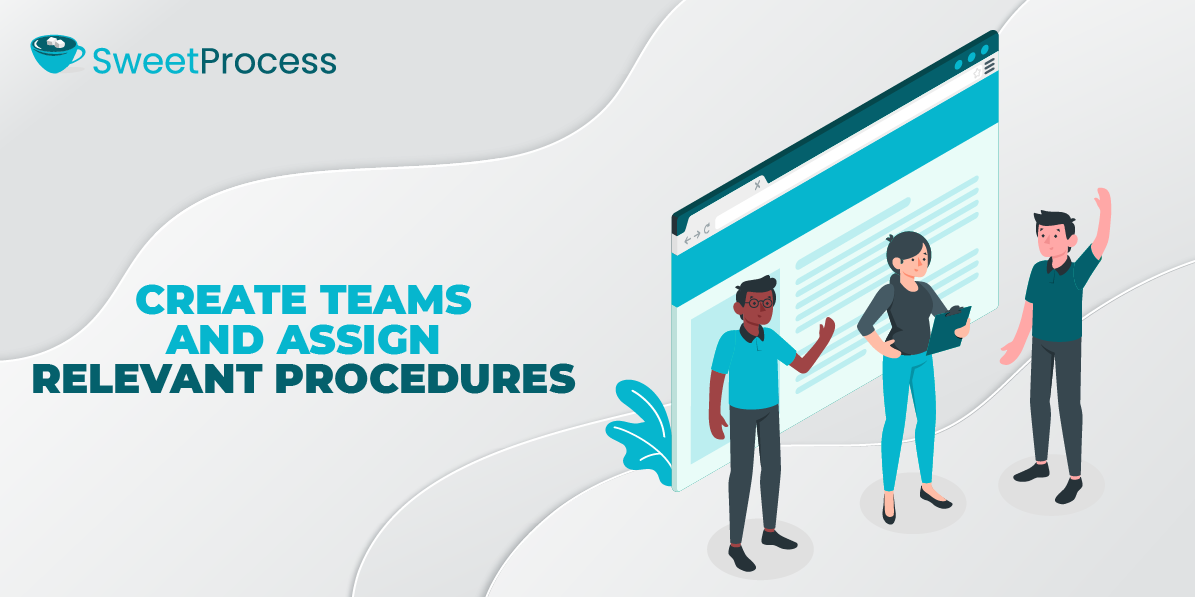
Organizing processes by teams ensures that each department knows its responsibilities and has access to the necessary workflows.
Here’s how to create a team:
- From the top navigation bar, click on the “More” tab, then select “Teams.”
- Click the “Create a Team” button on the Teams page.
- Enter the team’s name and description, such as IT Support or Marketing.
- Click “Create” to finalize the team.
Assigning workflows to teams ensures accountability and clarity, streamlining collaboration across departments.
2. Updating and Versioning
Edit Procedures and Processes to Keep Them Current
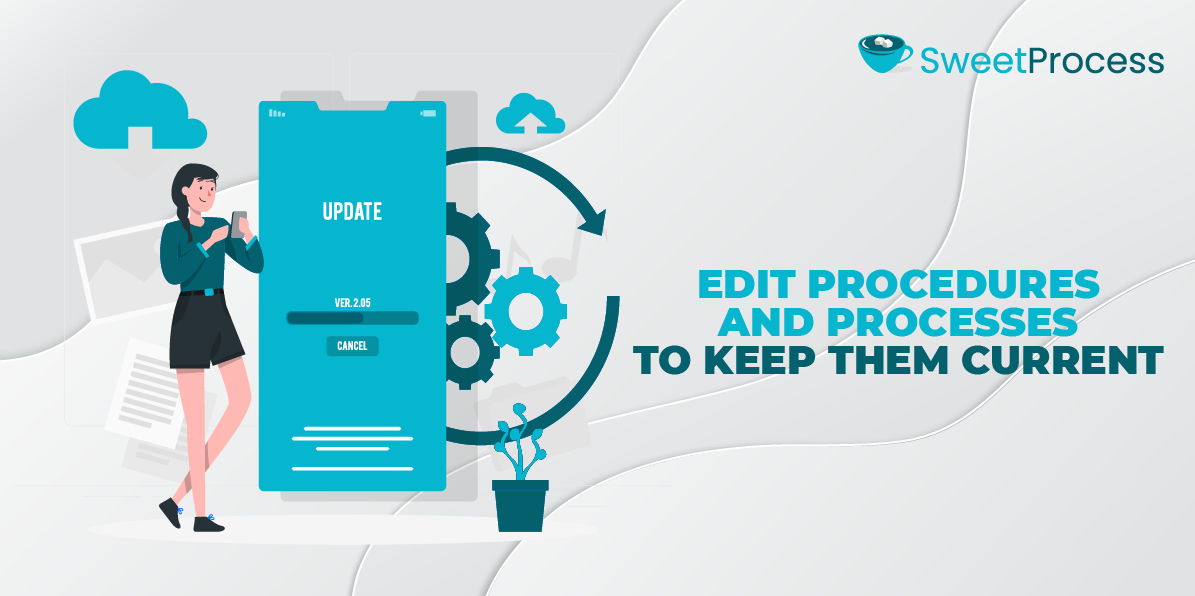
Workflows evolve, and SweetProcess allows you to edit procedures and processes seamlessly to ensure they reflect the latest requirements. Regular updates keep your workflows aligned with your business goals and the latest industry standards.
Track Version History
One standout feature of SweetProcess is its version history tracking, which allows you to monitor and compare changes made to a process over time. This ensures transparency and helps maintain accurate documentation.
Here’s how to view version history:
1) Access the Process: Navigate to the process you want to review by clicking its title in the processes tab.

2) Open the Version History Sidebar: Click the clock icon in the top menu to open the version history sidebar.
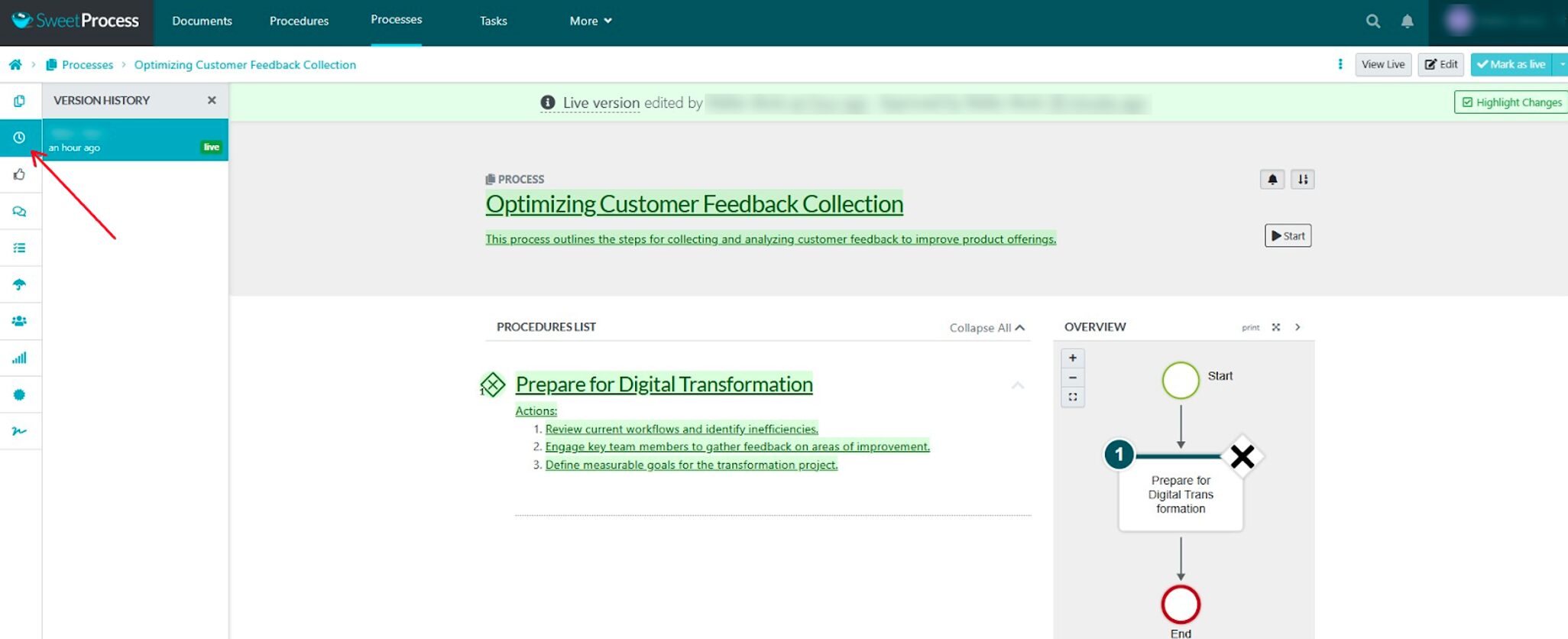
3) Select a Version: Choose a past version from the sidebar to review its contents.
4) Review and Compare: Examine the selected version for any changes in steps or procedures, such as additions, deletions, or modifications.
5) Revert if Necessary: If needed, revert the process to a previous version (permissions may be required).
How This Helps
Version tracking allows you to maintain an accurate and up-to-date record of your workflows. It also provides insights into how processes have evolved, ensuring you always work with the most effective version.
By leveraging SweetProcess’s management features, you can ensure that your procedures and processes are well-organized and continuously optimized for efficiency and accuracy.
This level of control is essential for driving a smooth and successful digital transformation.
Collaborate With Team Members
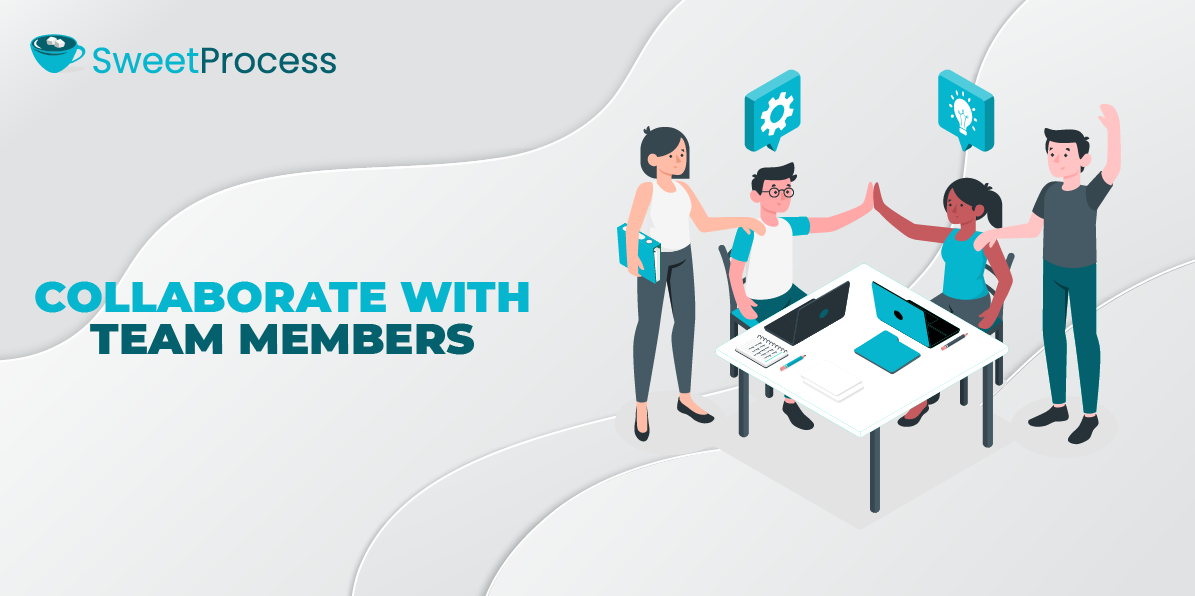
Successful digital transformation requires collaboration, where every team member’s input shapes processes and ensures workflows are as efficient and comprehensive as possible.
SweetProcess makes collaboration seamless by allowing team members to comment, provide feedback, and suggest improvements directly within procedures. This feature ensures that ideas are captured, misunderstandings are minimized, and processes evolve through shared knowledge.
Here’s how you can collaborate with your team using SweetProcess:
1. Open the Procedure
Start by navigating to the procedure you want to collaborate on.
- Go to the procedures tab on the top menu.
- Click on the specific procedure, such as Automating Customer Feedback Collection, to open it.
2. Access the Comment Feature
On the procedure page, locate the comment bubble icon. This icon opens the comment section where discussions about the procedure can take place.
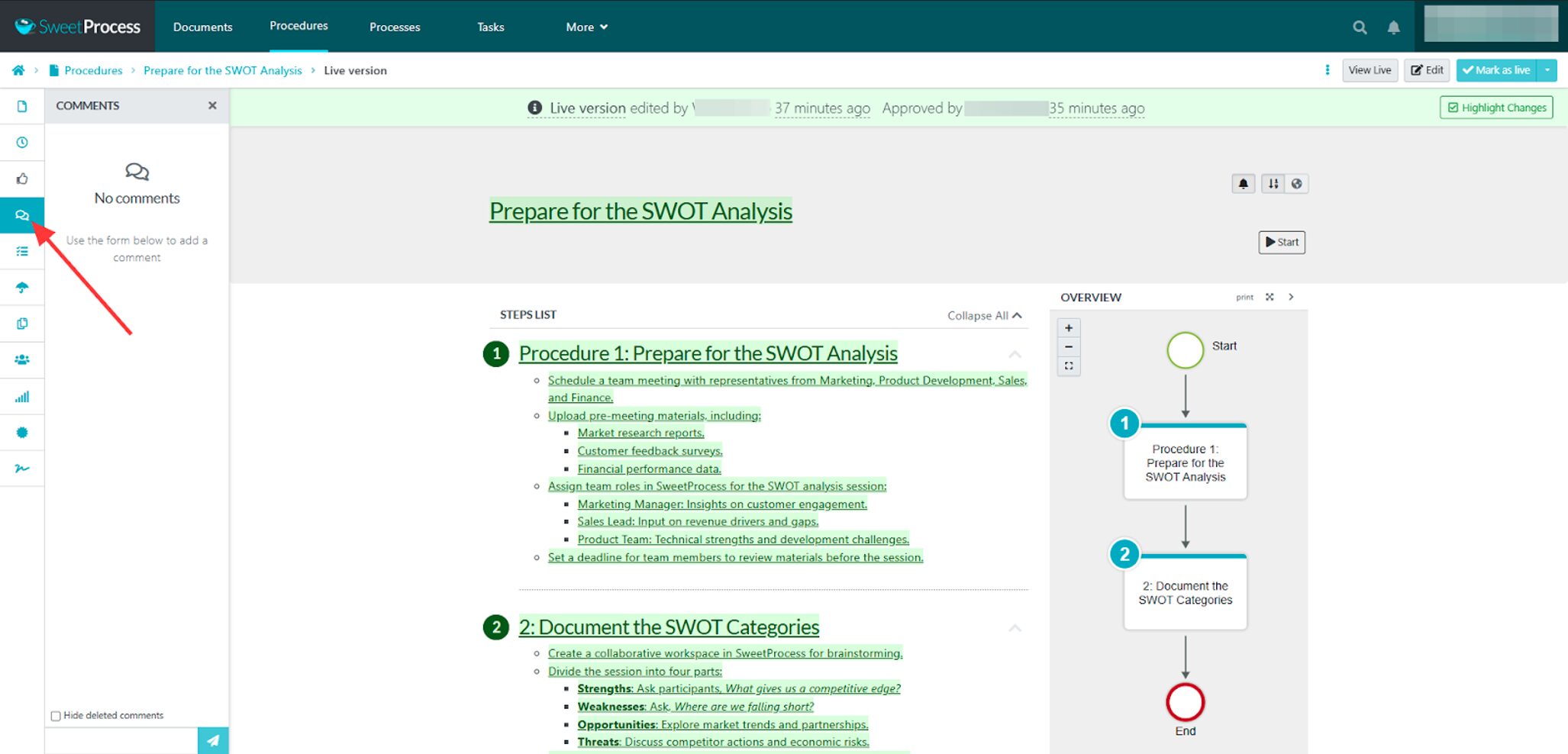
3. Leave a Comment
Use the comment box to provide feedback, share insights, or suggest updates. Be specific and add context to ensure your suggestions are actionable and clear.
Example Comment:
“Should we integrate a CRM tool into this process to track customer feedback more effectively?”
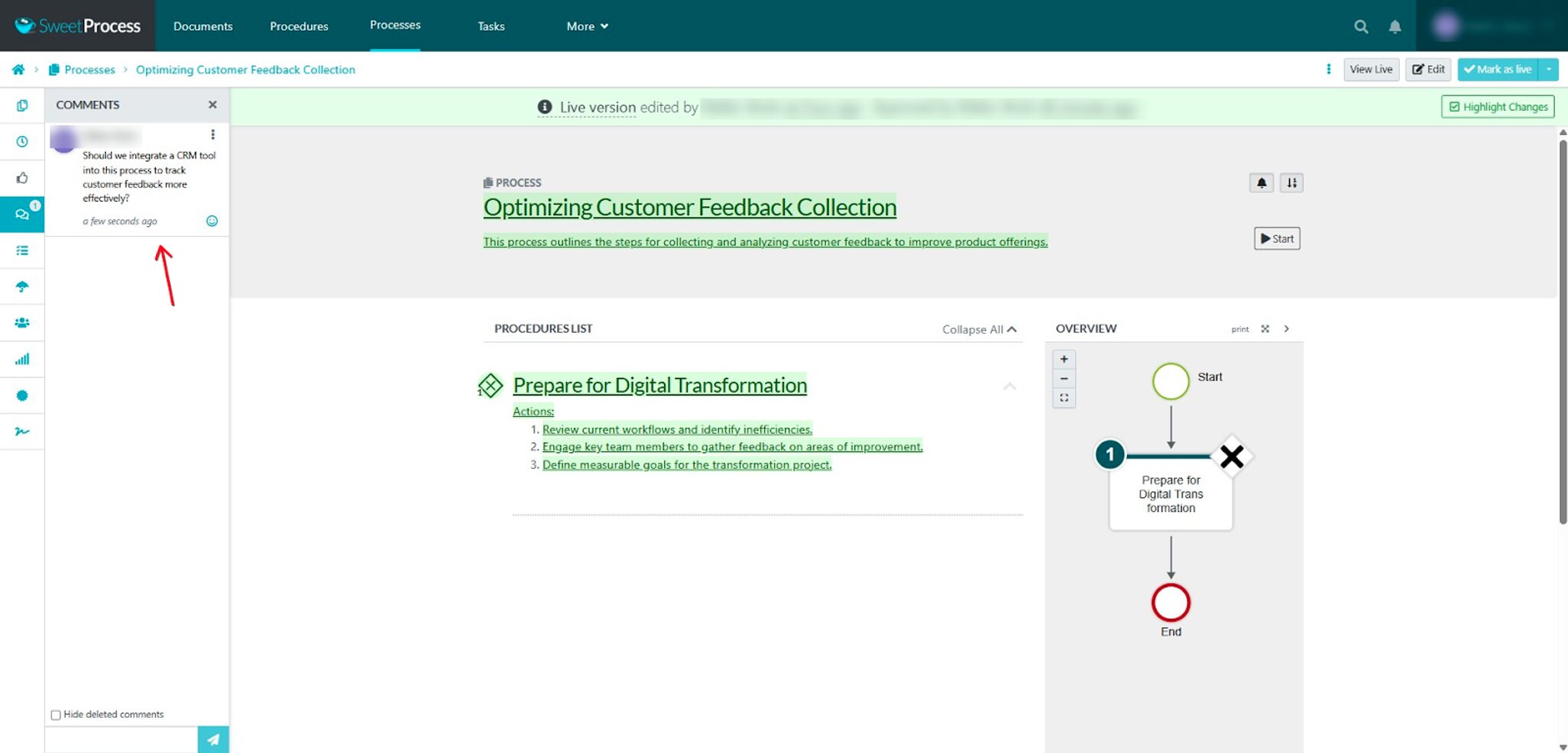
Comments are visible to the managers of the procedure and anyone who has previously contributed, fostering an open and inclusive discussion.
4. Send the Comment
Click the paper plane icon to submit your comment. SweetProcess instantly updates the procedure page, making your feedback accessible to relevant team members.
5. Respond to Feedback
SweetProcess ensures timely responses by notifying users via email when a comment is made. You can reply directly within SweetProcess or respond to the email, and your reply will be automatically added to the discussion. This feature keeps conversations centralized and eliminates the need for scattered email threads.
Collaboration ensures that processes are not just designed for theoretical efficiency but also for real-world execution. By leveraging your team’s collective knowledge, you can identify blind spots, refine workflows, and create a digital solution that works for everyone.
For example, during the rollout of a digital marketing automation process, a team member might suggest including a step for training staff on the new tools to ensure smooth implementation and adoption.
Once your team has contributed and refined your workflows, you’re now ready to implement and monitor these processes effectively.
How to Accelerate Digital Transformation (in 9 Steps)
Digital transformation is critical to modern business transformation efforts, reshaping how organizations operate and deliver value.
Here are nine strategic steps to help you fast-track your digital transformations, aligning your business with the demands of a digital-first world.
1. Build an IT Roadmap That Aligns With Your Business Goals
Before diving into new technologies, take a step back and define your objectives. What are you trying to achieve?
Start by evaluating your existing IT infrastructure. Identify systems, tools, and processes that are outdated, inefficient, or no longer aligned with your business needs.
- Are your current tools scalable enough to support future growth?
- Do you have legacy systems causing bottlenecks in workflows?
- What is the feedback from employees on existing technology?
This assessment helps you understand where you are, which is crucial for planning where you want to go.
Then, work closely with leadership teams to outline your company’s strategic objectives. Your IT roadmap should directly address these goals.
For example:
- If your goal is to improve customer retention, the roadmap might include upgrading your CRM system.
- If scaling operations is the priority, consider cloud solutions for flexibility and scalability.
Once your goals are clear, identify IT projects that align with those objectives and prioritize them based on urgency, impact, and resource availability.
2. Provide Upskilling Training to Improve Your Workforce’s Digital Literacy
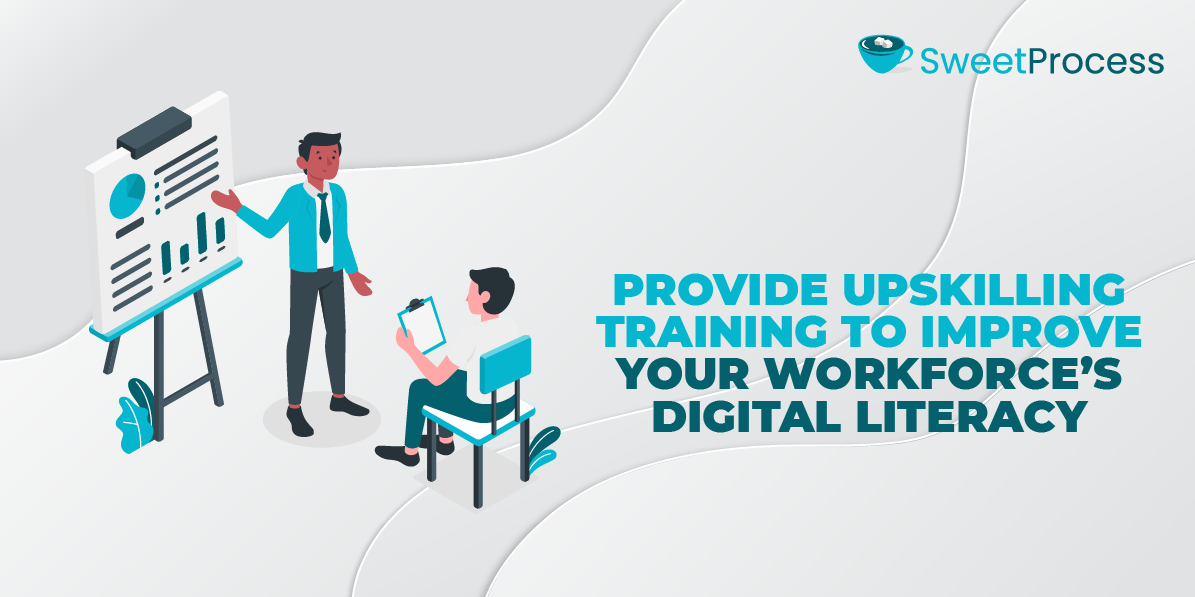
Your team is your greatest asset—but only if they can handle new technologies.
Providing upskilling training to improve your workforce’s digital literacy is critical to ensuring the success of your digital transformation efforts.
Start by identifying gaps in your team’s digital skills.
- Conduct surveys or assessments to determine areas where employees need support.
- For example, do team members struggle with data analysis, or are they unfamiliar with collaboration tools like Slack or Microsoft Teams?
This evaluation ensures training programs address the most critical needs.
Next, select a format that suits your workforce and resources. Options include:
- Online Courses: Flexible and scalable for remote or hybrid teams
- Workshops: Hands-on sessions for practical learning
- Mentorship Programs: Pairing less tech-savvy employees with digitally proficient colleagues
For example, online courses like Coursera or LinkedIn Learning can help employees learn independently.
Don’t forget to make training relatable by using examples and tasks that reflect daily responsibilities.
For instance, a sales team can practice generating reports using a new CRM system, or a finance team can simulate automating expense approvals.
Practical exercises ensure employees understand how to apply their new skills effectively.
Investing in robust learning and development programs ensures your workforce remains adaptable and proficient with new technologies.
3. Invest in Customer Experiences That Meet Their Needs
Customers are at the heart of digital transformation. Use data and feedback to understand their needs and invest in tools and strategies that deliver seamless, personalized experiences.
Understand your customers’ journey, from discovering your brand to becoming loyal advocates.
- Identify key touchpoints: website visits, social media interactions, customer support calls, etc.
- Pinpoint pain points or areas of friction in the journey.
For instance, are customers abandoning their carts due to a cumbersome checkout process? Mapping the journey provides clarity on where improvements are needed.
Then use this customer data to deliver tailored experiences.
- Analyze browsing history, purchase patterns, and feedback to anticipate needs.
- Implement AI tools to provide personalized recommendations or dynamic pricing.
4. Monitor the Adoption of New Employee-Based Applications and Customer-Facing Experiences
Introducing new tools is just the first step. Track how employees and customers use them to identify improvement areas and ensure widespread adoption.
Without proper monitoring, businesses risk underutilizing the tools they’ve invested in. For example:
- Employees may struggle with new software, leading to inefficiencies.
- Customers may find new features confusing, reducing satisfaction. Monitoring ensures these challenges are identified and addressed early, paving the way for smoother transitions and better results.
Use SweetProcess to document workflows and monitor progress in real time. Here is how to do it:
- Assign Tasks: Assign specific tasks to team members within procedures or processes. To ensure accountability, you can set due dates, reminders, and repetition settings (e.g., daily or weekly tasks).
- Track Activity: SweetProcess provides real-time activity tracking, allowing you to monitor who works on what task and whether deadlines are being met.
- Version Control: Keep track of procedure changes with version control features. This ensures transparency and allows you to revert to previous versions if necessary.
Adoption isn’t a one-time event—it’s a process. Use the insights gathered from monitoring to refine applications and processes.
- For employee tools, update features based on feedback to enhance usability.
- For customer-facing tools, implement improvements that address common pain points.
For instance, if customers frequently abandon their carts at checkout, simplifying the payment process could significantly boost adoption.
5. Adopt an Agile Approach to All Business Operations and Processes
Agility is a fundamental shift in how businesses operate to respond quickly and effectively to changes.
An agile approach focuses on:
- Flexibility: Adjusting processes and strategies quickly in response to feedback or market shifts.
- Iterative Progress: Breaking down large projects into smaller, manageable tasks that are delivered incrementally.
- Collaboration: Encouraging cross-functional teamwork and open communication.
- Customer Focus: Continuously refining processes to deliver greater value to customers.
Large-scale initiatives, like overhauling your customer service system, can be daunting. Break them into smaller tasks or “sprints” to make progress more manageable.
For example, instead of implementing an entire CRM system at once, start with importing customer data, training employees on basic features, and then expanding to advanced functions.
This iterative process ensures early wins and reduces risks by addressing challenges incrementally.
Agility also thrives on collaboration between teams. Create cross-functional teams that include members from various departments to provide diverse perspectives.
For instance, when redesigning your website, involve IT, marketing, and customer support to ensure the final product meets technical, branding, and user experience goals.
6. Invest in Tools and Build Processes That are Reusable and Can Be Repurposed

Don’t reinvent the wheel. Invest in tools and create processes that can be adapted for different projects or departments, saving time and resources in the long run.
SweetProcess is an excellent example of a tool that supports this approach, enabling businesses to document, manage, and optimize processes that can be easily repurposed.
How does SweetProcess support reusability?
SweetProcess allows you to document all your business processes in one centralized platform. This ensures that workflows are standardized and accessible, making them easy to reuse across teams.
- Example: A workflow for customer onboarding can be adapted for partner onboarding by simply tweaking a few steps, saving time and effort.
You can also create templates for commonly used procedures. These templates can be customized to meet the needs of different departments or projects.
For instance, a task approval workflow template the marketing team uses can be slightly modified and applied to IT projects, maintaining consistency across teams.
A good example is Spark Marketer, a Nashville-based marketing agency that struggled with disorganized workflows and a lack of standardized processes.
Employees depended on tribal knowledge to complete tasks, and documentation in tools like Google Docs proved cumbersome and inefficient. To scale their business effectively, Spark Marketer needed a tool that could create reusable and adaptable processes.
They signed up with SweetProcess. With its modular design and tagging features, SweetProcess allowed the company to document workflows in a way that could be repurposed across departments. For example, a customer onboarding process was quickly adapted to support contractor onboarding, saving time and ensuring consistency.
The flexibility of SweetProcess also enabled Spark Marketer to update procedures effortlessly, making them reusable as the business evolved. Employees now access only the workflows relevant to their roles, reducing confusion and improving efficiency.
7. Provide Your Employees With Performance Self-Support Tools
Performance self-support tools boost individual accountability and enhance overall productivity by enabling employees to identify areas for improvement without constant managerial oversight.
Employees who can independently access and interpret their performance metrics are better equipped to:
- Recognize strengths and address weaknesses
- Set personal goals aligned with organizational objectives
- Stay motivated and engaged, knowing their progress is measurable and actionable
Providing these tools fosters a culture of ownership and continuous improvement, reducing the reliance on supervisors for day-to-day guidance.
For instance, a project management tool like Monday.com or Asana can show task completion rates, deadlines, and team contributions, helping employees prioritize tasks effectively.
Also, they should be equipped with tools with features for employees to receive and act on feedback.
For example, SweetProcess allows employees to document their tasks and workflows, track their progress, and flag areas where additional guidance or updates are needed.
- An employee tasked with updating customer records can refer to a standardized procedure in SweetProcess, complete the task efficiently, and mark it as done.
- If they encounter issues, they can flag the procedure for updates, ensuring it remains relevant and accurate for future use.
This level of autonomy boosts confidence and ensures employees remain aligned with organizational goals.
8. Become a Data-Driven Company
Data is the backbone of digital transformation.
According to a study by McKinsey, organizations that leverage customer behavioral insights outperform their peers by 85% in sales growth and see more than 25% improvement in gross margin.
This demonstrates the competitive edge data-driven companies gain by making informed, proactive decisions rather than relying on intuition or outdated information.
Invest in tools and systems that can efficiently collect, store, and analyze data.
- Cloud-based platforms like AWS, Azure, or Google Cloud enable seamless data integration and accessibility across teams.
- Centralize information from multiple sources, such as CRM systems, e-commerce platforms, and social media analytics, using a data warehouse or lake.
And to fully leverage data, move beyond descriptive analytics, and embrace predictive and prescriptive analytics.
- Predictive analytics uses historical data to forecast future outcomes, such as customer churn or sales spikes.
- Prescriptive analytics recommends specific actions, such as adjusting inventory levels based on seasonal demand.
Finally, data should be accessible to employees across departments while maintaining appropriate security protocols. For example, marketing teams should have access to customer behavior insights, and sales teams should have real-time purchasing trends.
You can use tools like Tableau or Power BI to create dashboards tailored to specific roles. These dashboards allow employees to explore data relevant to their responsibilities.
9. Communicate Transparently With Employees

Transformation can be unsettling, so keep your team in the loop. Share updates, celebrate wins, and address concerns to build trust and encourage buy-in.
So, clearly articulate the purpose of your digital transformation and the goals you aim to achieve.
Example: “Our goal is to streamline operations by automating repetitive tasks, freeing up time for creative and strategic work.”
Link these goals to how they benefit employees, such as reducing workload, increasing efficiency, or opening up new growth opportunities.
Also, create a safe environment where employees can voice concerns or ask questions.
- Hold Q&A sessions during meetings or provide an anonymous feedback channel.
- Be honest about challenges, such as delays or unexpected hurdles, and explain how they’re being addressed.
For example: “We understand the new CRM system has a steep learning curve. We’ve scheduled additional training sessions to support you during the transition.”
Finally, celebrate the roles employees play in driving transformation success.
- Recognize teams or individuals who adapt quickly or suggest improvements.
- Use examples to show how their efforts directly impact the company’s growth.
Example: “Thanks to your feedback, we’ve optimized our automation tool, saving the team 15 hours a week.”
With these strategies and tools, you can streamline the process and achieve your goals faster. SweetProcess is here to help you document, manage, and optimize your processes every step of the way.
5 Real-Life Examples of Digital Transformation to Learn From
Digital transformation has enabled numerous organizations to revolutionize their operations, enhance customer experiences, and achieve significant growth. Here are five real-life examples illustrating how companies have successfully implemented digital transformation strategies:
1. Netflix
Before the digital transformation, Netflix operated as a DVD-by-mail rental service, competing with traditional video stores like Blockbuster. Customers had to wait for DVDs to arrive in the mail to watch their favorite movies.
Since implementing its digital transformation strategy, Netflix has:
- Pioneered streaming services, fundamentally changing how people consume content
- Developed a recommendation algorithm using AI to personalize user experiences
- Leveraged cloud computing for improved storage and content delivery
- Introduced a subscription-based model for streaming, disrupting traditional content monetization
These changes propelled Netflix from a small e-commerce model to a Fortune 500 SaaS company, with its valuation reaching $384.89 billion as of December 2024.
2. Mayo Clinic
Prior to digital transformation, Mayo Clinic relied on traditional healthcare delivery models and physical infrastructure for patient care.
Mayo Clinic’s digital transformation journey includes:
- Creating a Center for Digital Health to drive innovation
- Developing a digital front door for improved patient experience
- Expanding virtual care options
- Implementing an advanced care at home program, allowing some patients to receive hospital-level care in their homes
- Leveraging data analytics to transform healthcare delivery
These initiatives aim to bring Mayo Clinic to a global community, delivering care in a simple and accessible manner.
3. Walmart
Walmart dominated the retail industry with its brick-and-mortar stores but struggled to compete with e-commerce giants like Amazon.
Walmart invested heavily in its digital infrastructure, including a robust e-commerce platform, mobile app, and omnichannel strategies like curbside pickup and same-day delivery. They also used data analytics to optimize inventory management and personalize customer experiences.
The Impact:
- Became the second-largest online retailer in the US, behind Amazon
- Increased customer loyalty through seamless shopping experiences
- Improved supply chain efficiency, reducing costs and waste
4. Coursera
Education was largely confined to physical classrooms, limiting access for many due to geographic, financial, or time constraints.
Coursera leveraged the internet to offer online courses from top universities and institutions. They used digital technology to create interactive learning experiences, including video lectures, quizzes, and peer-reviewed assignments.
The Impact:
- Democratized education, making it accessible to millions worldwide
- Partnered with over 200 universities and companies to offer thousands of courses
- Enabled lifelong learning and upskilling for professionals
5. Airbnb
Before its digital transformation, the hospitality industry was dominated by traditional hotels and booking systems.
Airbnb created a digital platform connecting travelers with unique accommodations hosts offer. They used this new technology to streamline booking, payments, and reviews, creating a seamless user experience.
The Impact:
- Disrupted the hospitality industry, offering affordable and unique lodging options
- Empowered individuals to monetize their properties and become entrepreneurs
- Expanded to over 220 countries and regions, becoming a global travel leader
These examples demonstrate how digital transformation can revolutionize industries, improve customer experiences, and create new business models across various sectors.
6 Digital Transformation Strategies and Roadmaps
A well-structured approach ensures that your transformation aligns with your business goals and delivers measurable outcomes. Here are six key strategies to guide you in creating a robust digital transformation roadmap:
1. Kick Off With Discovery
The first step in any digital transformation project is understanding where your business currently stands.
- Conduct a comprehensive analysis of your existing processes, systems, and workflows.
- Gather insights from stakeholders across departments to identify inefficiencies, redundancies, and opportunities for improvement.
By starting with discovery, you set a solid foundation for identifying what needs to change and why.
2. Define Your Digital Vision

Your digital vision is the “why” behind your transformation. It’s a clear, compelling statement of what you want to achieve and how technology will help you get there.
- Ask questions like: What do we want to achieve with this transformation? How will it impact our customers, employees, and operations?
- Translate your vision into actionable goals, such as improving customer satisfaction, streamlining operations, or increasing agility.
3. Determine Your Digital Maturity
Digital maturity refers to how effectively your organization uses technology to achieve its goals. Understanding your maturity level helps you identify where you are and where you need to go.
- Use frameworks like the Digital Maturity Model to assess areas such as technology adoption, data usage, and employee readiness.
- Understanding your maturity level helps prioritize initiatives and allocate resources effectively.
4. Identify Capability Gaps
Once you know your digital maturity, identify the gaps between your current state and your digital vision.
For example, if your goal is to enhance customer experiences, but your CRM system is outdated, upgrading or replacing it becomes a priority.
Capability gaps might also include a lack of digital skills within your workforce, which can be addressed through upskilling programs.
5. Build Your Transformation Roadmap
A transformation roadmap is a detailed plan that outlines the steps, timelines, and resources needed to achieve your digital vision.
Break your journey into manageable phases, focusing on quick wins early to build momentum.
Example: Phase 1 could involve automating repetitive tasks, while Phase 2 focuses on integrating AI-driven analytics into decision-making processes.
6. Consider Cloud Applications
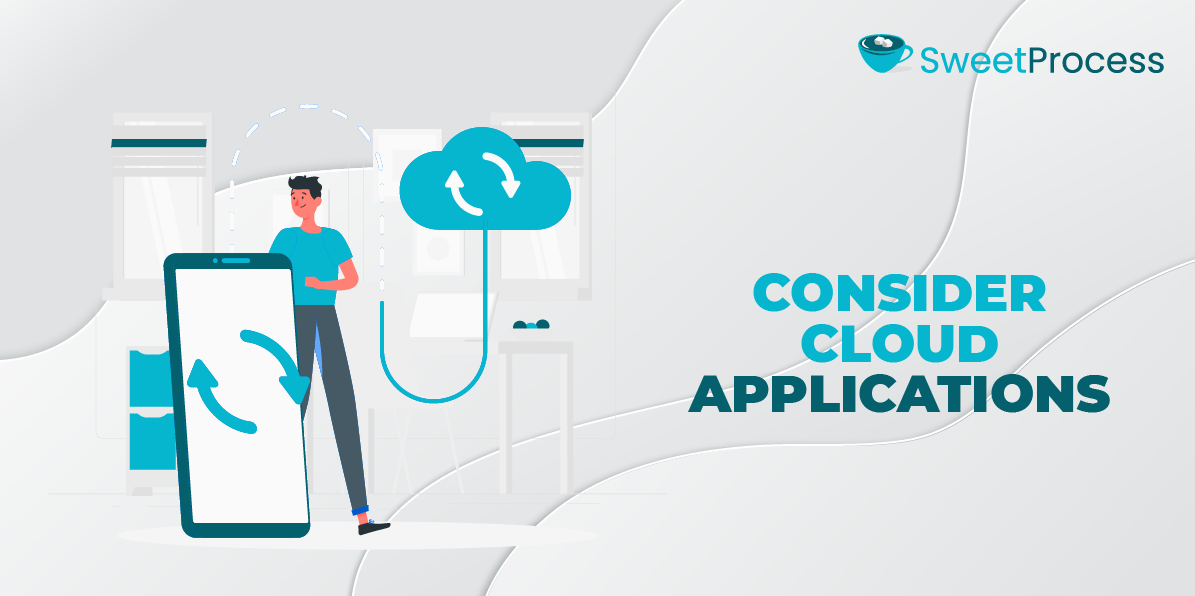
Cloud technology is a cornerstone of modern digital transformation strategies.
They provide scalability, flexibility, and cost-efficiency, making them ideal for businesses of all sizes.
Transitioning to cloud-based tools like SweetProcess ensures that your processes are accessible, organized, and easily updated as your transformation evolves.
Challenges of Digital Transformation and How to Overcome Them
From technological hurdles to cultural shifts, these obstacles can slow progress if not addressed strategically.
Here are four common challenges organizations face during digital transformation and how to overcome them.
1. Technological and Implementation Barrier
Introducing new technologies often involves a steep learning curve and integration issues with legacy systems. Inadequate technical expertise and resistance from employees further complicate the process.
How To Overcome It
- Conduct a thorough assessment of existing systems and select technologies that align with your business needs
- Provide comprehensive training to employees to build confidence and ease adoption
- Partner with experienced vendors or consultants to streamline implementation
For instance, using a tool like SweetProcess can simplify the transition by providing a centralized platform to document workflows, making it easier for teams to adapt to new systems.
Using the right change management software can simplify the adoption of new technologies and ensure a smoother transition.
2. Cultural and Skill-Related Challenges
Resistance to change and a lack of digital skills among employees can hinder progress. Digital transformation framework requires a cultural shift toward embracing innovation and continuous learning.
How To Overcome It
- Foster a culture of openness by communicating the benefits of transformation clearly
- Invest in upskilling programs to enhance digital literacy
- Recognize and reward employees who embrace new technologies and processes
- Strong focus on organizational change management to foster a culture of adaptability and innovation
3. Strategic Alignment and Sustainability
Digital transformation initiatives often fail due to a lack of alignment between technology investments and business goals. Poor planning and short-term thinking can also result in unsustainable efforts.
How To Overcome It
- Develop a digital strategy that ties directly to your organization’s long-term objectives.
- Use a phased approach to implement changes, ensuring each step builds toward a sustainable future.
- Regularly evaluate and adjust your strategy based on results and feedback.
A structured change management process is essential for aligning digital transformation efforts with long-term business goals.
4. Data Privacy and Budgetary Constraints

The increasing reliance on digital tools raises concerns about data security and compliance with privacy regulations. At the same time, many organizations struggle to balance the costs of transformation with their budgets.
How To Overcome It
- Invest in secure, compliant technologies and implement best practices for data protection
- Focus on cost-effective solutions that deliver a strong return on investment
- Prioritize projects with the highest impact to make the most of limited budgets
SweetProcess is an affordable yet powerful tool that helps businesses manage digital transformation effectively without overspending. Its features allow you to centralize processes securely and monitor progress efficiently. Start your free trial of SweetProcess today.
The Role of AI in Digital Transformation
Generative AI’s role in digital transformation is multifaceted and far-reaching, impacting various business operations and strategy aspects.
AI is at the heart of modern innovation, from automating repetitive tasks to enabling data-driven decision-making.
Here’s a closer look at how AI transforms businesses and why it’s critical to any digital transformation strategy.
1. Automating Processes for Efficiency
AI-powered automation can handle repetitive, time-consuming tasks, freeing up employees to focus on higher-value activities.
Examples:
- Chatbots for customer service, reducing response times, and improving satisfaction
- Robotic process automation (RPA) for tasks like data entry, invoicing, and payroll processing
- AI-driven workflows that streamline operations and reduce errors
This increases efficiency, reduces costs, and allows businesses to scale without adding significant overhead.
2. Enhancing Decision-Making With Data Insights
AI can analyze vast amounts of data in real time, uncovering patterns and insights that humans might miss.
Examples:
- Predictive analytics for forecasting demand, optimizing inventory, and reducing waste
- AI-driven dashboards that provide actionable insights for executives and managers
- Machine learning models that identify trends and opportunities in customer behavior
Data-driven decisions lead to better resource allocation, improved customer targeting, and a stronger competitive edge.
3. Personalizing Customer Experiences
AI enables businesses to deliver highly personalized experiences by analyzing customer data and predicting preferences.
Examples:
- Recommendation engines that suggest products or content based on user behavior
- Personalized marketing campaigns that target specific customer segments
- AI-powered CRM systems that track interactions and tailor communications
Personalization drives customer loyalty, increases engagement, and boosts revenue.
4. Improving Operational Agility
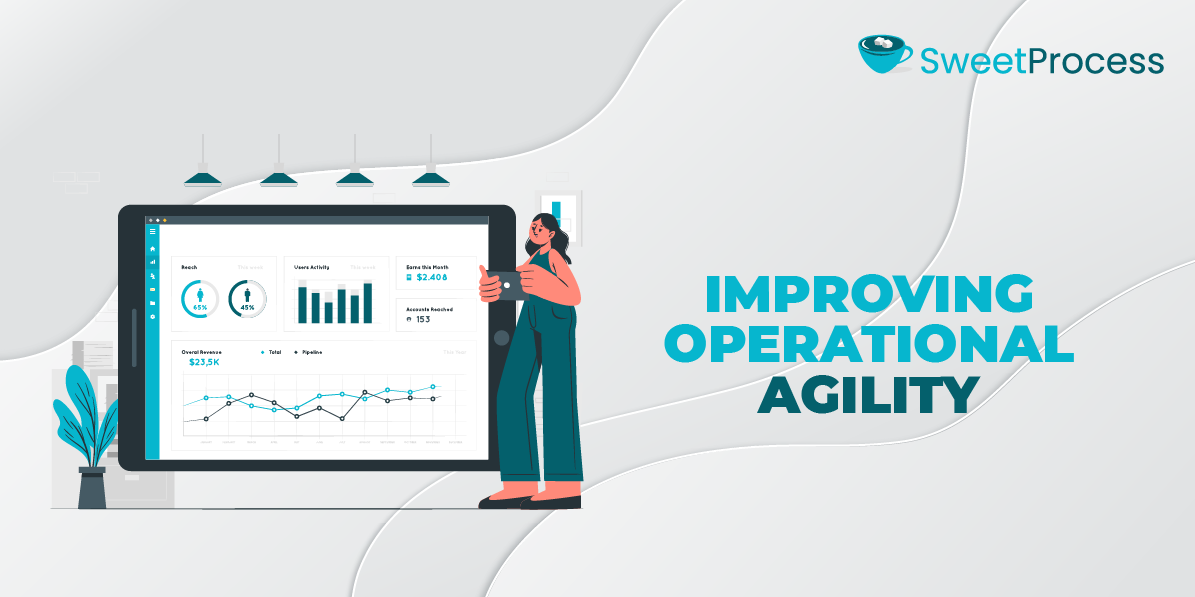
AI helps businesses adapt quickly to changes by providing real-time insights and enabling rapid adjustments.
Examples:
- AI-powered supply chain management that responds to disruptions in real-time
- Dynamic pricing models that adjust based on market conditions
- AI tools that monitor performance and recommend optimizations
Agility is essential in a fast-changing world, and AI empowers businesses to stay ahead of the curve.
5. Enhancing Security and Risk Management
AI can identify and mitigate risks by analyzing patterns and detecting anomalies. This protects sensitive data and reduces the risk of costly breaches.
Examples:
- Fraud detection systems that flag suspicious transactions
- Cybersecurity tools that monitor networks for threats and vulnerabilities
- AI-driven compliance systems that ensure adherence to regulations
6. Driving Innovation and New Business Models
AI opens the door to new products, services, and revenue streams by enabling innovative solutions.
Examples:
- AI-powered healthcare tools for diagnostics and personalized treatment
- Smart home devices that learn user preferences and automate tasks
- AI-driven platforms that connect businesses with new markets and customers
Faster innovation cycles allow companies to bring cutting-edge products to market more quickly.
Enhance Your Company’s Digital Transformation Process Using SweetProcess
Digital transformation initiatives are necessary for businesses that want to stay competitive, efficient, and future-ready.
But as we’ve explored throughout this article, the journey isn’t without its challenges. From aligning your strategy to overcoming cultural resistance, the path to transformation requires careful planning, execution, and management.
A recurring theme in every aspect of this journey is the importance of documenting and managing your processes effectively.
SweetProcess simplifies the complexities of digital transformation by providing a centralized platform to document workflows, optimize procedures, and ensure team alignment. By integrating SweetProcess into your transformation strategy, you can:
- Streamline Operations: Create clear, reusable workflows that save time and enhance efficiency
- Improve Employee Engagement: Equip your team with easy-to-follow procedures, fostering confidence and productivity
- Drive Scalability: Standardize processes to support growth and adapt to changing business needs
- Facilitate Collaboration: Enable seamless communication and accountability across teams
Whether you’re overcoming implementation challenges, aligning strategies, or leveraging cutting-edge technologies like AI, SweetProcess helps you stay on track and achieve your digital transformation goals.
Sign up for a free trial today and experience how streamlined processes can unlock your organization’s full potential—no credit card required.

